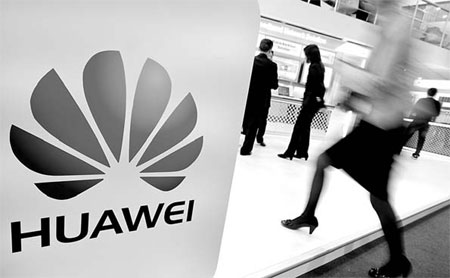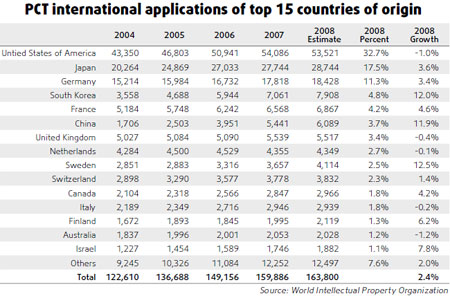Slump Takes its Toll on Patents

International patent filings under World Intellectual Property Organization's (WIPO) Patent Cooperation Treaty (PCT) grew 2.4 percent in 2008, to nearly 164,000 applications.
While the rate of growth was modest, compared to an average of 9.3 percent over the previous three years, the total number of applications in 2008 represented the highest number of applications received under the PCT in a single year.
Continued use of the PCT, a cornerstone of the international patent system, indicated that companies recognize the importance of sustained investment in research, development and innovation to remain competitive even within challenging economic conditions.
Inventors from South Korea (12 percent), China (11.9 percent) and Sweden (12.5 percent) enjoyed robust growth rates in their filing of PCT applications in 2008. The largest number of international PCT applications, just under a third of the total for 2008 (32.7 percent or 53,521 applications) were filed by inventors in the United States of America, maintaining a ranking that has spanned some 30 years.
"Historically, patent filings tend to dip during periods of economic difficulty simply because fewer resources are available for investment in the innovation cycle. Once the economic cycle improves, patenting activity also tends to recover. That said, economic crises have, in the past, been a catalyst for innovation as greater emphasis is placed on improving standards of efficiency, doing more with less and identifying and developing smarter business solutions," said WIPO Director-General Francis Gurry.
"In the current economic climate, technology, innovation and creativity are critical in creating opportunities for economic renewal and addressing pressing global issues such as climate change," he added.
Inventors and corporations from Japan, with 17.5 percent (28,774) of all filings, clinched the number two spot in 2008, followed by Germany (18,428), South Korea (7,908) France (6,867), China (6,089), the United Kingdom (5,517), the Netherlands (4,349), Sweden (4,114), Switzerland (3,832), Canada (2,966), Italy (2,939), Finland (2,119), Australia (2,028) and Israel (1,882). In 2008, China improved its ranking by one place, to become the sixth-largest user of the PCT.
Top applicants
For the first time, a Chinese company topped the list of PCT applicants in 2008. Huawei Technologies Co, Ltd, a major international telecommunications company based in Shenzhen, filed 1,737 PCT applications in 2008. Panasonic Corporation from Japan was the second-largest user of the PCT in 2008 with 1,729 international applications, followed by Koninklijke Philips Electronics NV of the Netherlands with 1,551 PCT applications, Toyota Jidosha Kabushiki Kaisha of Japan with 1,364 PCT applications, and 1,273 PCT applications filed by Germany's Robert Bosch GMBH.
Of the top 100 companies using the PCT system in 2008, 38 were from the United States, 28 from Japan and 13 from Germany. Another Chinese company, ZTE Corporation, also a Shenzen-based telecommunications company, featured in the top 100.
Developing countries
WIPO continued to receive international patent applications from developing countries in 2008. The largest number of applications received came from South Korea (7,908) and China (6,089), followed by India (766), Singapore (578), Brazil (451), South Africa (382), Turkey (367), Mexico (210), and Malaysia (177).
Developing countries account for 78 percent of the membership of the PCT, representing 109 of the 139 countries that have so far signed the treaty.
"In the coming years, it will be a priority for WIPO to work closely with its member states to ensure that all countries are in a position to actively participate in the benefits of innovation and the knowledge economy, and maximize their participation in the PCT," said Gurry.
He recalled that WIPO's Development Agenda calls for continual analysis and reflection on the best means of making intellectual property work to the advantage of all countries, regardless of their level of development.
Fields of technology
The largest proportion of PCT applications published in 2008 related to the medical technology, computer technology and pharmaceutical sectors, with 12 percent, 8.5 percent and 7.9 percent respectively. The fastest growing technology areas are information technology methods for management, with an increase of 22.7 percent, and microstructures and nanotechnology, which rose 20.7 percent.
A review of PCT operations is ongoing to ensure that the PCT system continues to deliver value-added services to users and is a more effective platform for sharing information among patent offices to avoid duplication of work, and for facilitating access to valuable patent information. WIPO's revised program and budget states that the PCT's strategic direction in 2009 is "to ensure that the PCT system is being used to its full potential and to maximize its value to applicants and member states".
The director-general said: "PCT has been a major success in providing a multilateral response to the growth in demand for patents and the internationalization of the system. Demand for patent rights in today's technology-dependent societies, however, is such that patent offices around the world are struggling to deliver their IP services in an efficient and timely manner. In the face of this demand management crisis, there is an urgent need to find solutions."
Gurry said that "PCT provides a better basis for constructing future solutions than any other currently under consideration".
Modernization efforts
In recent years, WIPO and other patent offices have sought to continually enhance and modernize PCT operations to generate efficiency gains and to better serve the user community. As a result of this, some 70 percent of all PCT applications are now filed fully or partially in electronic form. WIPO has also streamlined PCT operations so that staff numbers have remained stable in spite of a continuing increase in workload.
Also, users are able to do full-text searches in over 1.5 million published international patent applications filed since 1978. Partly in recognition of these efficiency gains, member states agreed in 2007 to reduce the PCT international fee by 5 percent as of July 1, 2008. In order to encourage the use of the PCT in developing countries, the international filing fee is now reduced by 90 percent for individual applicants (not companies) from an approved list of developing countries and by 90 percent for all applicants from less developed countries.
Advantageous route
PCT offers inventors and industry an advantageous route to obtaining patent protection internationally. By filing one "international" patent application under the PCT, protection of an invention can be sought simultaneously in each of a large number of countries. Both applicants and patent offices of PCT member states benefit from the uniform formality requirements, the international search and preliminary examination reports, and the centralized international publication provided by the PCT system. The national patent granting procedure and the related expenses are postponed, in the majority of cases, by up to 18 months (or even longer in the case of some offices) as compared with the traditional patent system. By this time, the applicant will have received important value-added information concerning the likelihood of obtaining patent protection as well as potential commercial interest in that invention.
Growth rates in the filing of PCT applications have been particularly dynamic over the past nine years. It took 18 years from the beginning of PCT operations in 1978 to reach 250,000 total applications, but only four years to double that figure, and another four to double it again.
World Intellectual Property Organization

(China Daily 02/23/2009 page11)
2013-07-17 Print
Print